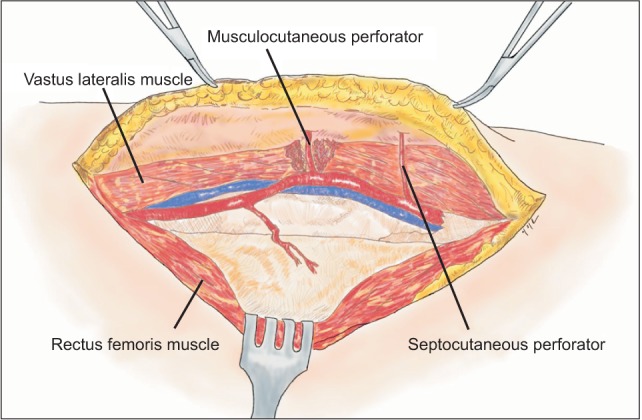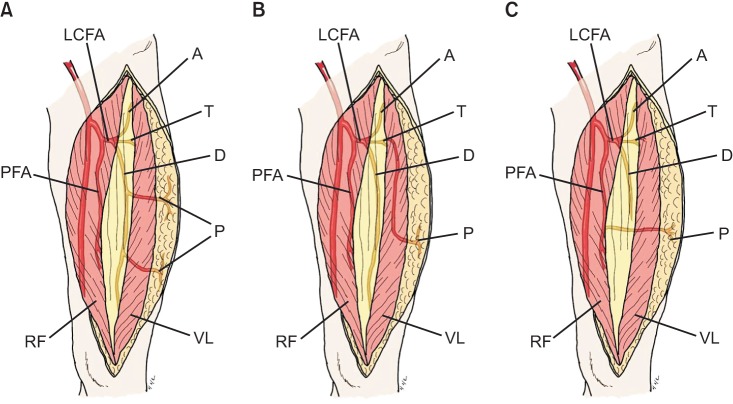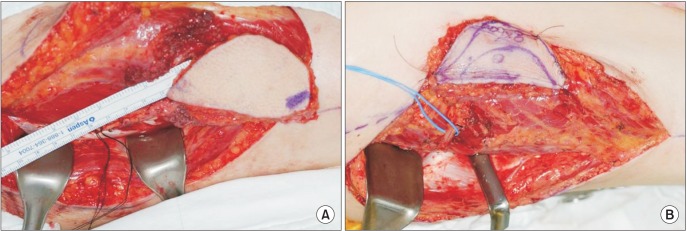J Korean Assoc Oral Maxillofac Surg.
2016 Oct;42(5):265-270. 10.5125/jkaoms.2016.42.5.265.
Surgical implications of anatomical variation in anterolateral thigh flaps for the reconstruction of oral and maxillofacial soft tissue defects: focus on perforators and pedicles
- Affiliations
-
- 1Department of Oral and Maxillofacial Surgery, Asan Medical Center, Seoul, Korea. jeehoman@naver.com
- KMID: 2356252
- DOI: http://doi.org/10.5125/jkaoms.2016.42.5.265
Abstract
OBJECTIVES
To gain information on anatomical variation in anterolateral thigh (ALT) flaps in a series of clinical cases, with special focus on perforators and pedicles, for potential use in reconstruction of oral and maxillofacial soft tissue defects.
MATERIALS AND METHODS
Eight patients who underwent microvascular reconstructive surgery with ALT free flaps after ablative surgery for oral cancer were included. The number of perforators included in cutaneous flaps, location of perforators (septocutaneous or musculocutaneous), and the course of vascular pedicles were intraoperatively investigated.
RESULTS
Four cases with a single perforator and four cases with multiple perforators were included in the ALT flap designed along the line from anterior superior iliac spine to patella. Three cases had perforators running the septum between the vastus lateralis and rectus femoris muscle (septocutaneous type), and five cases had perforators running in the vastus lateralis muscle (musculocutaneous type). Regarding the course of vascular pedicles, five cases were derived from the descending branch of the lateral circumflex femoral artery (type I), and three cases were from the transverse branch (type II).
CONCLUSION
Anatomical variation affecting the distribution of perforators and the course of pedicles might prevent use of an ALT free flap in various reconstruction cases. However, these issues can be overcome with an understanding of anatomical variation and meticulous surgical dissection. ALT free flaps are considered reliable options for reconstruction of soft tissue defects of the oral and maxillofacial area.
MeSH Terms
Figure
Reference
-
1. Song YG, Chen GZ, Song YL. The free thigh flap: a new free flap concept based on the septocutaneous artery. Br J Plast Surg. 1984; 37:149–159. PMID: 6713155.
Article2. Choi SW, Park JY, Hur MS, Park HD, Kang HJ, Hu KS, et al. An anatomic assessment on perforators of the lateral circumflex femoral artery for anterolateral thigh flap. J Craniofac Surg. 2007; 18:866–871. PMID: 17667679.
Article3. Wei FC, Jain V, Celik N, Chen HC, Chuang DC, Lin CH. Have we found an ideal soft-tissue flap? An experience with 672 anterolateral thigh flaps. Plast Reconstr Surg. 2002; 109:2219–2226. discussion 2227-30. PMID: 12045540.
Article4. Lin SJ, Rabie A, Yu P. Designing the anterolateral thigh flap without preoperative Doppler or imaging. J Reconstr Microsurg. 2010; 26:67–72. PMID: 19672820.
Article5. Kimata Y, Uchiyama K, Ebihara S, Nakatsuka T, Harii K. Anatomic variations and technical problems of the anterolateral thigh flap: a report of 74 cases. Plast Reconstr Surg. 1998; 102:1517–1523. PMID: 9774005.
Article6. Kawai K, Imanishi N, Nakajima H, Aiso S, Kakibuchi M, Hosokawa K. Vascular anatomy of the anterolateral thigh flap. Plast Reconstr Surg. 2004; 114:1108–1117. PMID: 15457020.
Article7. Valdatta L, Tuinder S, Buoro M, Thione A, Faga A, Putz R. Lateral circumflex femoral arterial system and perforators of the anterolateral thigh flap: an anatomic study. Ann Plast Surg. 2002; 49:145–150. PMID: 12187341.
Article8. Yu P. Reinnervated anterolateral thigh flap for tongue reconstruction. Head Neck. 2004; 26:1038–1044. PMID: 15459922.
Article9. Wong CH, Wei FC, Fu B, Chen YA, Lin JY. Alternative vascular pedicle of the anterolateral thigh flap: the oblique branch of the lateral circumflex femoral artery. Plast Reconstr Surg. 2009; 123:571–577. PMID: 19182615.
Article10. Urken ML, Cheney ML, Blackwell KE, Harris JR, Hadlock TA, Futran N. Atlas of regional and free flaps for head and neck reconstruction. 2nd ed. Philadelphia: Lippincott Williams & Wilkins;2012.11. Nakayama B, Hyodo I, Hasegawa Y, Fujimoto Y, Matsuura H, Yatsuya H, et al. Role of the anterolateral thigh flap in head and neck reconstruction: advantages of moderate skin and subcutaneous thickness. J Reconstr Microsurg. 2002; 18:141–146. PMID: 12007048.
Article12. Chana JS, Wei FC. A review of the advantages of the anterolateral thigh flap in head and neck reconstruction. Br J Plast Surg. 2004; 57:603–609. PMID: 15380693.
Article13. Xu DC, Zhong SZ, Kong JM, Wang GY, Liu MZ, Luo LS, et al. Applied anatomy of the anterolateral femoral flap. Plast Reconstr Surg. 1988; 82:305–310. PMID: 3399560.14. Pan SC, Yu JC, Shieh SJ, Lee JW, Huang BM, Chiu HY. Distally based anterolateral thigh flap: an anatomic and clinical study. Plast Reconstr Surg. 2004; 114:1768–1775. PMID: 15577347.
Article15. Zhou G, Qiao Q, Chen GY, Ling YC, Swift R. Clinical experience and surgical anatomy of 32 free anterolateral thigh flap transplantations. Br J Plast Surg. 1991; 44:91–96. PMID: 2018912.
Article16. Yu P, Sanger JR, Matloub HS, Gosain A, Larson D. Anterolateral thigh fasciocutaneous island flaps in perineoscrotal reconstruction. Plast Reconstr Surg. 2002; 109:610–616. discussion 617-8. PMID: 11818843.
Article17. Koshima I. Free anterolateral thigh flap for reconstruction of head and neck defects following cancer ablation. Plast Reconstr Surg. 2000; 105:2358–2360. PMID: 11242347.
- Full Text Links
- Actions
-
Cited
- CITED
-
- Close
- Share
- Similar articles
-
- Chimeric anterolateral thigh flap for reconstruction of complex defects in oral cancer: a report of three cases
- Reconstruction of the Tissue Defects of Extremities with Anterolateral Thigh Free Flap
- Reconstruction of Head and Neck Defects with Anterolateral Thigh Free Flap
- Reconstruction of Soft Tissue Defect of Knee Joint Area Using Anterolateral Thigh Perforator Flap
- Reliability of the Anterior Thigh Free Flap for Reconstruction of the Extremities




